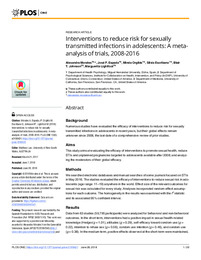Por favor, use este identificador para citar o enlazar este ítem:
https://hdl.handle.net/11000/30845Registro completo de metadatos
| Campo DC | Valor | Lengua/Idioma |
|---|---|---|
| dc.contributor.author | Morales, Alexandra | - |
| dc.contributor.author | ESPADA, JOSE P. | - |
| dc.contributor.author | Orgilés, Mireia | - |
| dc.contributor.author | ESCRIBANO, SILVIA | - |
| dc.contributor.author | Johnson, Blair | - |
| dc.contributor.author | Lightfoot, Marguerita | - |
| dc.contributor.other | Departamentos de la UMH::Psicología de la Salud | es_ES |
| dc.date.accessioned | 2024-01-30T18:03:00Z | - |
| dc.date.available | 2024-01-30T18:03:00Z | - |
| dc.date.created | 2018-06-28 | - |
| dc.identifier.citation | PLoS ONE 13(6):e0199421., 2018 | es_ES |
| dc.identifier.issn | 1932-6203 | - |
| dc.identifier.uri | https://hdl.handle.net/11000/30845 | - |
| dc.description.abstract | Background Numerous studies have evaluated the efficacy of interventions to reduce risk for sexually transmitted infections in adolescents in recent years, but their global effects remain unknown since 2008, the last date of a comprehensive review of prior studies. Aims This study aims at evaluating the efficacy of interventions to promote sexual health, reduce STIs and unplanned pregnancies targeted to adolescents available after 2008; and analyzing the moderators of their global efficacy. Methods We searched electronic databases and manual searches of some journals focused on STIs in May 2016. The studies evaluated the efficacy of interventions to reduce sexual risk in adolescents (age range: 11–19) anywhere in the world. Effect size of the relevant outcomes for sexual risk was calculated for every study. Analyses incorporated random-effect assumptions for each outcome. The homogeneity in the results was examined with the I2 statistic and its associated 95% confident interval. Results Data from 63 studies (59,795 participants) were analyzed for behavioral and non-behavioral outcomes. In the short term, interventions had a positive impact in sexual health-related knowledge (Hedges’g = 1.01), attitudes (g = 0.29), self-efficacy toward condom use (g = 0.22), intention to refuse sex (g = 0.56), condom use intention (g = 0.46), and condom use (g = 0.38). In the medium term, positive effects observed at the short-term were maintained, although effect size significantly decreased in all variables. In the long term, interventions improved condom use (g = 0.47). Moderators of the efficacy are discussed. Conclusions Sexual health promotion interventions are effective to promote sexual health through increasing condom use. Effects on non-behavioral variables tend to decrease over time, while condom use increased in the long-term. Interventions should focus on the long-term efficacy, especially in behavioral and biological measures. | es_ES |
| dc.format | application/pdf | es_ES |
| dc.format.extent | 26 | es_ES |
| dc.language.iso | eng | es_ES |
| dc.publisher | Public Library of Science | es_ES |
| dc.rights | info:eu-repo/semantics/openAccess | es_ES |
| dc.rights.uri | http://creativecommons.org/licenses/by-nc-nd/4.0/ | * |
| dc.subject.classification | Personalidad, evaluación y tratamiento psicológico | es_ES |
| dc.subject.other | CDU::1 - Filosofía y psicología::159.9 - Psicología | es_ES |
| dc.title | Interventions to reduce risk for sexually transmitted infections in adolescents: A meta-analysis of trials, 2008-2016 | es_ES |
| dc.type | info:eu-repo/semantics/article | es_ES |
| dc.relation.publisherversion | https://doi.org/10.1371/journal.pone.0199421 | es_ES |

Ver/Abrir:
aportacion 2- metaanalisis.pdf
2,31 MB
Adobe PDF
Compartir:
 La licencia se describe como: Atribución-NonComercial-NoDerivada 4.0 Internacional.
La licencia se describe como: Atribución-NonComercial-NoDerivada 4.0 Internacional.
.png)